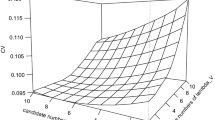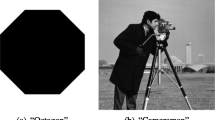Abstract
Principal Component Filter Bank (PCFB) is considered optimal in terms of coding gain for specific conditions. P P Vaidyanathan stated that coding gain does not necessarily always increase with the increase in the number of bands. However, very few attempts are made in the literature to go beyond the confines of work done by P P Vaidyanathan. We present the analytic proofs for the monotonicity of specific shapes of PSDs. This papers also derives properties of coding gain of PCFBs, which brings the new insights on the coding gain of Principal Component Filter Banks.






Similar content being viewed by others
References
Tsatsanis M K and Giannakis G B 1995 Principal component filter banks for optimal multiresolution analysis. IEEE Trans. Signal Process. 43(8): 1766–1777
Vaidyanathan P P and Akkarakaran S 2001 A review of the theory and applications of optimal subband and transform coders. Appl. Comput. Harmon. Anal. 10(3): 254–289
Akkarakaran S and Vaidyanathan P P 2001 Filterbank optimization with convex objectives and the optimality of principal component forms. IEEE Trans. Signal Process. 49(1): 100–114
Vaidyanathan P P 1998 Theory of optimal orthonormal subband coders. IEEE Trans. Signal Process. 46(6): 1528–1543
Xuan B and Bamberger R I 1998 FIR principal component filter banks. IEEE Trans. Signal Process. 46(4): 930–940
Tkacenko A 2004 Optimization algorithms for realizable signal-adapted filter banks. California Institute of Technology, Pasadena, United States.
Vouras P G and Tran T D 2006 Design of FIR paraunitary approximations to principal component filter banks. In: 2006 40th Annual Conference on Information Sciences and Systems, pp. 1372–1377
Vouras P G and Tran T D 2005 Principal component filter bank for band partitioned sidelobe cancellation. In: IEEE International Radar Conference, 2005, pp. 691–696
Jhawar A, Ginde P, Patwardhan P and Gadre V M 2010 Coding gain optimized finite impulse response (FIR) paraunitary (PU) filter banks. In: 2010 National Conference on Communications (NCC), pp. 1–5
Redif S, McWhirter J G and Weiss S 2011 Design of FIR paraunitary filter banks for subband coding using a polynomial eigenvalue decomposition. IEEE Trans. Signal Process., 59(11): 5253–5264
Fatimah B and Joshi S 2015 An optimal biorthogonal M-channel signal matched FIR filter bank. In: 2015 International Conference on Computational Science and Computational Intelligence (CSCI), pp. 443–447
Vaidyanathan P P 1993 Multirate Systems and Filter Banks. Engelwood Cliffs, NJ: Prentice Hall PTR.
Chaphekar P 2020 New Results and Design Techniques for Principal Component Filter Banks. PhD thesis, Indian Institute of Technology, Bombay, India.
Author information
Authors and Affiliations
Corresponding author
Appendix: Subband variance of triangular PSD
Appendix: Subband variance of triangular PSD
Consider a triangular PSD with the subbands designed for PCFB. For M subbands, the frequency support of each band will be \(\frac{\pi }{M}\). For \(M=5\), these subbands will appear as shown in figure 7. The first subband will be from \(\omega _4\) to \(\omega _5\). The second subband will be from \(\omega _3\) to \(\omega _4\) and \(\omega _5\) to \(\omega _6\). The third subband will be from \(\omega _2\) to \(\omega _3\) and \(\omega _6\) to \(\omega _7\), and so no. Then,
\( \text {Subband variance} = \frac{1}{\pi } \times \text {Area under the PSD for subband}. \)
Thus,
The area of the second subband can be computed by finding the area of parts numbered 1 and 2 combined and then subtracting the area of the first subband. Thus,
The area of subsequent subbands can be found in a similar manner. In general,
Rights and permissions
About this article
Cite this article
Chaphekar, P., Bhatia, A., Bhatnagar, S. et al. Insights on coding gain and its properties for principal component filter banks. Sādhanā 48, 76 (2023). https://doi.org/10.1007/s12046-023-02142-y
Received:
Revised:
Accepted:
Published:
DOI: https://doi.org/10.1007/s12046-023-02142-y





